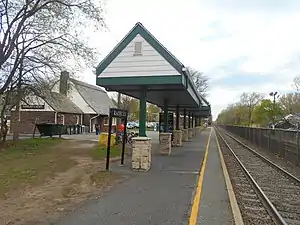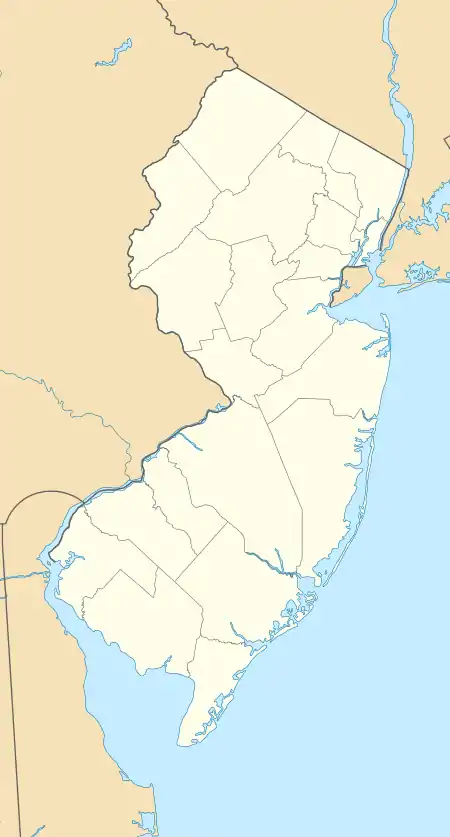Radburn | |||||||||||||
|---|---|---|---|---|---|---|---|---|---|---|---|---|---|
 The 1929 station depot at Radburn is on the left in May 2014. | |||||||||||||
| General information | |||||||||||||
| Location | Pollitt Drive at Fair Lawn Avenue (CR 76), Fair Lawn, New Jersey | ||||||||||||
| Coordinates | 40°56′23″N 74°07′18″W / 40.9396°N 74.1217°W | ||||||||||||
| Owned by | New Jersey Transit | ||||||||||||
| Platforms | 2 side platforms | ||||||||||||
| Tracks | 2 | ||||||||||||
| Connections | |||||||||||||
| Other information | |||||||||||||
| Fare zone | 6[1] | ||||||||||||
| History | |||||||||||||
| Opened | October 1, 1881[2][3] | ||||||||||||
| Rebuilt | April–October 1929[4][5] | ||||||||||||
| Passengers | |||||||||||||
| 2018 | 1,592 (average weekday)[6] | ||||||||||||
| Services | |||||||||||||
| |||||||||||||
| |||||||||||||
Radburn-Fair Lawn Station | |||||||||||||
 The depot at Radburn in May 2014. | |||||||||||||
   | |||||||||||||
| Location | Pollitt Drive, Fair Lawn, New Jersey | ||||||||||||
| Coordinates | 40°56′22″N 74°7′19″W / 40.93944°N 74.12194°W | ||||||||||||
| Area | 0.3 acres (0.1 ha) | ||||||||||||
| Built | 1929 | ||||||||||||
| Architect | Clarence S. Stein | ||||||||||||
| Architectural style | Dutch Colonial Revival | ||||||||||||
| MPS | Operating Passenger Railroad Stations TR | ||||||||||||
| NRHP reference No. | 84002580[7] | ||||||||||||
| NJRHP No. | 483[8] | ||||||||||||
| Significant dates | |||||||||||||
| Added to NRHP | June 22, 1984 | ||||||||||||
| Designated NJRHP | March 17, 1984 | ||||||||||||
Radburn is a New Jersey Transit train station in the Dutch Colonial Revival style, served by the Bergen County Line. It is on Fair Lawn Avenue in the Radburn section of Fair Lawn, in Bergen County, New Jersey, United States. It is one of two New Jersey Transit train stations in Fair Lawn, the other being Broadway.
The station was designed and built in 1929 by Clarence Stein, as part of the Radburn development. It has been listed in the state and federal Registers of Historic Places since 1984 and is part of the Operating Passenger Railroad Stations Thematic Resource.[7][8][9][10]
History

The location of the Radburn development was considered beneficial because of its location on the Erie Railroad with connections to Jersey City, Newark and Manhattan. The designers of the development saw the benefit of a suburban railroad station for planning throughout the New York Metropolitan Area. In July 1928, they proposed the Fairlawn Station Square with a depot that cost $60,000 (1928 USD) and would serve those who would be in the neighborhood after construction of the first 200 homers. The new depot would serve Suffern to the north and Hoboken to the southeast along with connections in the area.[11]
A new railroad depot was constructed on the Bergen County Railroad in 1929. The depot replaced a wooden freight depot that served the area. This new station was designed by Clarence Stein in a Dutch Colonial Revival to keep the idea of modern and efficient and in a similar style of the Radburn neighborhood. The new Radburn station had three sections: a central area that contained the 640-foot (200 m) waiting room and ticket office. This new pavilion contained a sloping and overhanging roof. This south wing of the depot contained the restrooms, and the north wing contained the office of the track supervisor, the baggage room and a porch for customers. The depot had a sandstone design with 14-foot (4.3 m) vaulted ceilings with a slate roof and clapboarding siding.[11]
Station layout
The station has two tracks, each with a low-level side platform. It is staffed with a station agent on weekday mornings.
| Ground/ Platform level |
Side platform, doors will open on the right | |
| Track 1 | ← Bergen County Line toward Waldwick or Suffern (Glen Rock – Boro Hall) ← Port Jervis Line does not stop here | |
| Track 2 | Port Jervis Line does not stop here → Bergen County Line toward Hoboken (Broadway) → | |
| Side platform, doors will open on the right | ||
| Street level | Station building, ticket machines, parking | |
See also
Bibliography
- Clayton, W. Woodford (1882). History of Bergen and Passaic Counties, New Jersey: With Biographical Sketches of Many of Its Pioneers and Prominent Men. Philadelphia, Pennsylvania: Everts & Peck. Retrieved July 28, 2020.
- Poor, Henry Varnum (1884). Poor's Manual of Railroads. Pittsburgh, Pennsylvania: H.V. & H.W. Poor. Retrieved July 28, 2020.
References
- ↑ "Main and Bergen County Line Timetables" (PDF). Newark, New Jersey: New Jersey Transit Rail Operations. November 7, 2010. Archived from the original (PDF) on January 24, 2002. Retrieved November 27, 2010.
- ↑ Poor 1884, p. 167.
- ↑ Clayton 1882, p. 203.
- ↑ "Plan New Railroad Station Serve the Town of Radburn". The Paterson Morning Call. April 15, 1929. p. 2. Retrieved July 28, 2020 – via Newspapers.com.

- ↑ "Radburn Railroad Station". The Bergen Evening Record. Hackensack, New Jersey. October 14, 1929. p. 26. Retrieved July 28, 2020 – via Newspapers.com.

- ↑ Kiefer, Eric (February 21, 2018). "Here Are New Jersey Transit's Most, Least-Used Train Stations". patch.com. Retrieved August 28, 2022.
- 1 2 "National Register Information System". National Register of Historic Places. National Park Service. March 13, 2009.
- 1 2 "New Jersey and National Registers of Historic Places". New Jersey Department of Environmental Protection - Historic Preservation Office. Retrieved January 7, 2015.
- ↑ Radburn New Jersey Transit Railroad Station Survey
- ↑ Bergen County Listings on the National Register of Historic Places (Building #84002580)
- 1 2 Edith B. Wallace; Paula S. Reed (June 2004). "National Historic Landmark Nomination: Radburn" (PDF). National Park Service. pp. 11, 41. Retrieved May 11, 2016.